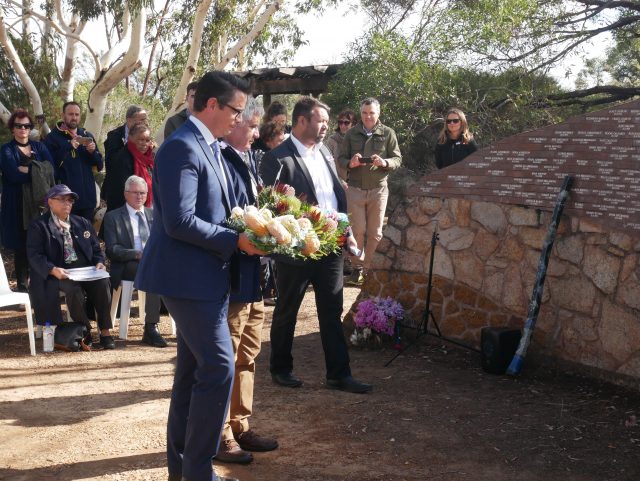On 26 May 2018, 100 years after it was erroneously established, a moving ceremony was held at the Moore River Native Settlement, which lies 11 kilometres west of Mogumber, near the headwaters of the Moore River. The ceremony offered an opportunity to reflect on the lives of the 374 persons of Aboriginal descent who perished at the settlement before it’s closure in 1974.
The stormy day heralded long-awaited rain, but the heavens cleared during the quiet service casting sunlight on the bushland clearing where a stone wall bears the names of those who died. After a fitting Welcome to Country, speakers told of the sad history of the settlement, each explaining their links to those buried there as well as those who were born there. The hauntingly rythmic sounds of tapping sticks over the softly rustling trees solemnly recognised each soul who now rests in the area of largely unmarked graves.
Australia’s first Aboriginal federal minister, Ken Wyatt, and his nephew Ben Wyatt, Australia’s first Aboriginal state treasurer, were among the speakers who came to acknowledge their own family history at the settlement.
Ken Wyatt’s great-aunt Molly was one of the little girls immortalised in the film Rabbit Proof Fence – which tells the true story of a family torn apart by Australian legislation that allowed the forcible removal of mixed-race Aboriginal children from their parents.
Among other family links, state treasurer Ben’s father, Cedric was born at the mission in 1940 before being taken from his mother. Something Ben said his father never spoke of, which Ben only learned about later in life.
More than half the people buried at Moore River were children — 203 in total. Of these, 149 were five years old or less and more than 100 were under the age of one when they died. Most of the young died from afflictions easily treated now such as pneumonia, bronchitis and gastroenteritis – and the elderly from heart failure and senile decay.
Originally intended to be a self -supporting farming settlement for young aboriginal people from the Murchison, Midlands and south-west regions of Western Australia, the camp was established by the Government of Western Australia under the auspices of the Chief Protector of Aborigines Auber Neville. However, by the mid-1920’s it was clear the settlement was a failure. The land was unsuitable for cultivation and the camp became overpopulated as a result of being used as a dumping ground for the poor, sick and elderly. It had also became the forced home of many children from the stolen generation who were torn from their families on the misguided promise of education and training.
With a rising population, poor management and lack of funding, conditions at the camp were unsanitary and many of the inhabitants were riddled with sickness.
Socially, Moore River Native Settlement practiced strict segregation of the sexes and separated children from their parents under the dormitory system. Compound inmates were not allowed to leave without written permission. Absconding was a common problem as many tried to re-unite with family members living outside the settlement. To counter this practice, a small number of Aboriginal men were employed as trackers to apprehend absconders.
In 1951 the government handed control of the mission to the Methodist church, who renamed it Mogumber Native Mission. An increased focus on education and training emerged, but the after equal rights law came into effect in 1967 the institution became defunct and the area was taken over by the Aboriginal Land Trust. Currently the land is leased to the Wheatbelt Aboriginal Corporation, and is known as Budjarra.
The centenary of the mission fell curiously close to reconcilation week this year and is a fitting reminder for us as a nation to remember this part of our history. Reconciliation Australia is urging us ‘not to keep history a mystery’, painful as it may be.
If you find yourself wanting to acknowledge this part of Australia’s past I urge you to visit the memorial at the former Moore River Native Settlement site. It is marked by a small sign as you head west on the Mogumber West Rd. Although the place is full of sadness, it is also a monument to hope, and testament that as a nation we can say sorry for wrongs done in the past, and as a society we can change and evolve – learning from the past and looking forward to a more harmonious future.








